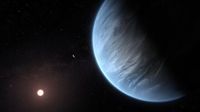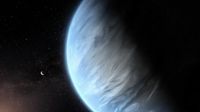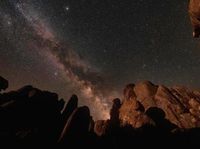In a groundbreaking discovery that could reshape our understanding of life beyond Earth, a team of researchers led by Indian-origin astrophysicist Dr. Nikku Madhusudhan has reported compelling evidence of biological activity on the exoplanet K2-18b, located over 120 light-years from our planet. Using NASA’s James Webb Space Telescope (JWST), the team found significant traces of carbon-bearing molecules in the planet’s atmosphere, including methane, carbon dioxide, and dimethyl sulfide (DMS), a molecule that, on Earth, is exclusively produced by living organisms.
Dr. Madhusudhan, a professor at the University of Cambridge, expressed optimism about the findings, stating, “This is the strongest evidence yet there is possibly life out there. I can realistically say that we can confirm this signal within one to two years,” as reported by the BBC. The discovery has ignited excitement in the scientific community, as it provides a glimpse into the potential for life on planets beyond our solar system.
K2-18b is classified as a “sub-Neptune” exoplanet, which means it is larger than Earth but smaller than Neptune. It orbits a cool red dwarf star in the Leo constellation and is situated within the habitable zone where conditions may allow for liquid water to exist. With a size approximately 2.6 times that of Earth and a mass about 8.6 times greater, K2-18b is considered a strong candidate for being a “Hycean world.” This term refers to planets with hydrogen-rich atmospheres and potentially ocean-covered surfaces—ideal conditions for supporting life.
The observations made by the JWST were particularly notable. The Near-Infrared Imager and Slitless Spectrograph (NIRISS) and Near-Infrared Spectrograph (NIRSpec) revealed the presence of methane and carbon dioxide, while the absence of ammonia was also recorded. Most intriguingly, researchers identified a possible hint of dimethyl sulfide (DMS), a compound that on Earth is a byproduct of biological processes, primarily from marine phytoplankton. However, NASA has cautioned that this potential detection is not yet confirmed, and further observations are required.
“Upcoming Webb observations should be able to confirm if DMS is indeed present in the atmosphere of K2-18b at significant levels,” the agency stated, emphasizing the need for caution despite the promising findings.
Dr. Nikku Madhusudhan, who was born in India in 1980, has made significant contributions to the field of exoplanetary science. He completed his B.Tech at the Indian Institute of Technology (IIT) BHU, followed by an M.S. and Ph.D. in Physics from the Massachusetts Institute of Technology (MIT). His research focuses on the atmospheres of exoplanets, planetary formation, and the potential for extraterrestrial life. In 2013, he joined the University of Cambridge as a professor, where he has continued to push the boundaries of our understanding of exoplanets.
Madhusudhan's work has led to the development of novel atmospheric retrieval techniques that analyze the spectra of distant exoplanets to determine their atmospheric composition. This innovative approach has opened new avenues for discovering habitable worlds, moving beyond Earth-like rocky planets to include those covered by oceans beneath thick hydrogen atmospheres.
In April 2025, the team’s observation of K2-18b provided additional evidence for the presence of DMS and dimethyl disulfide (DMDS), gases associated with living organisms on Earth. This discovery suggests that Hycean planets could have the right conditions to support life, broadening the scope of habitable worlds in the universe.
Dr. Madhusudhan stated, “If we confirm that there is life on K2-18b, it should basically confirm that life is very common in the galaxy.” This assertion underscores the significance of the ongoing research and the potential implications for our understanding of life in the cosmos.
The Fermi Paradox, which questions why we have not yet encountered intelligent life despite the vast number of potentially habitable planets, is reignited by these findings. The detection of a potential biosignature on K2-18b does not solve this paradox but may mark the beginning of a new chapter in humanity's quest to understand its place in the universe.
Looking ahead, the James Webb Space Telescope will continue to study K2-18b, and additional observations are planned to confirm the presence of DMS and refine atmospheric models for the exoplanet. The European Space Agency’s upcoming Ariel mission, set to launch in 2029, will also assist scientists in probing the atmospheres of exoplanets like K2-18b.
As researchers continue their investigations, the excitement surrounding K2-18b and the potential for discovering life beyond our solar system grows. The implications of such findings could fundamentally alter our understanding of life in the universe and our own existence.
In summary, the recent detection of carbon-bearing molecules in the atmosphere of K2-18b, particularly dimethyl sulfide, represents a significant milestone in the search for extraterrestrial life. The work of Dr. Nikku Madhusudhan and his team not only paves the way for future research but also inspires hope that we may not be alone in the cosmos.









